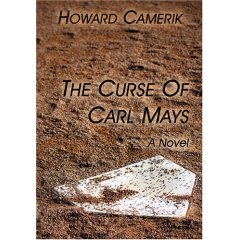
I’ll admit: when I first saw a description for Howard Camerik’s The Curse of Carl Mays, I was a bit skeptical, especially when I saw the book involved the 1986 World Series, the subject of that flop-written-all-over-it movie from last year, Game 6. Successful Boston mayor has baseball dreams left over from his aborted playing days, blames the 68 year World Series win drought on an ornery Red Sox pitcher (Carl Mays, a headhunter who supposedly learned his malicious ways from a Red Sox manager, sold by the Sox to the Yankees in 1919 and then went on to accidentally kill a player by hitting him in the head), plays for a senior league charity game in Yankee Stadium the day of Game 6, gets hit in the head Matt Clement style and then strange cosmic events occur? I tried describing the concept to Robin after I started reading the book (and had decided I liked the ways things were going) and it still didn’t come off well; Robin looked at me like I was nuts.
However, odd concept aside, once I started reading I found myself drawn in very, very quickly. Camerik is writing historical fiction, something I’ve always liked when well done and The Curse of Carl Mays is a great example of the genre for two reasons:
- Research: everything in Camerik’s book, from the layout of the Polo Grounds in 1920 to the political views of Bill Lee to the names of minor league baseball players with peripheral interest to the plot is meticulously researched, something that’s vital to any good piece of historical fiction, where attention to detail is very, very important. In the case of a book like The Curse of Carl Mays, where the main character (Boston mayor Pat McCarvill) is a fictional character inserted into highly documented situations like mayor of Boston and member of various minor and major league baseball teams, this amount of research is absolutely vital to making the plot work at all.
- Description: going along with the attention to detail in The Curse of Carl Mays is a good deal of description for characters, places and events, which help the reader to visualize exactly what’s going on. Description is certainly helpful in any piece of fiction, but it’s even more important when you’re writing about the past.
Another laudable element of Camerik’s tale is his use of flashbacks to tell the story of Pat McCarvill, both before and after the accident at the charity game that is the center point of the story. Doing so actually makes the whole book easier to digest than if Camerik had written everything in a linear fashion, as you have a few moments to switch back to the tense situation of the present (Game 6 of the 1986 World Series) before embarking on another flashback that fills in another vital detail of McCarvill’s life.
The one area I had a bit of a problem swallowing was the concept of the time traveling ambulance that changes the whole course of the story (yes, there’s a time traveling ambulance and yes, it’s actually vital to how things go down, so stop shaking your head like you’re losing faith in this book – it’s actually really good). To be honest, though, it’s not the concept of time travel itself that bothers me; I think the issue here is that Camerik has done such a good job establishing a reality in the first half of the book that changing that reality so drastically is a bit jarring.
On the whole though, if you’re looking for an exciting story about baseball, the Red Sox and more importantly, being a Red Sox fan, you can’t go wrong checking out Howard Camerik’s The Curse of Carl Mays.







